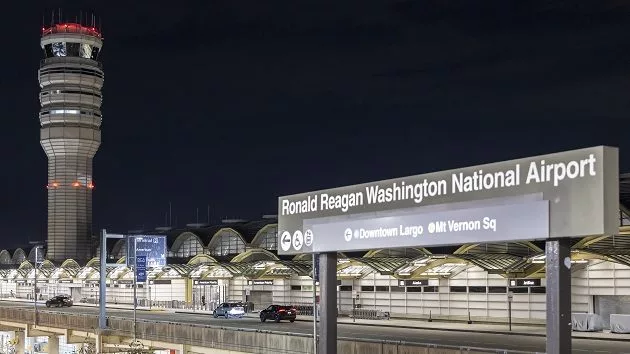
(WASHINGTON) — Pilots and air traffic controllers notified authorities about airplanes and helicopters flying alarmingly close at Reagan National Airport (DCA) in at least 15 incident reports dating back to 1991, according to an ABC News review of the reports.
Some of the reports warned that the flight space was “an accident waiting to happen” with others describing scenarios eerily close to what occurred when a military Black Hawk helicopter collided with American Airlines Flight 5342 last week as the passenger jet approached the airport.
“One of these incidents would have been too many,” said former Air Force pilot and ABC News aviation consultant John Nance. “This barometer is in the red. It’s telling us there is a real problem here. There is a very, very clear track record of something that needs to be fixed.”
There are at least four reports of safety incidents associated with runway 33, the same runway that AA 5342 was approaching when the collision that took 67 lives occurred.
“This has been happening too many times over the years, and it’s now led to a tragedy that could have been prevented,” said Steve Ganyard, a former Marine Corps fighter pilot and ABC News contributor.
The safety reports were filed with the Aviation Safety Reporting System, a program established by the FAA and managed by NASA that enables professionals within the aviation community to voluntarily and confidentially report safety concerns and incidents in a non-punitive manner.
In response to questions from ABC News, the FAA said, “Due to the ongoing NTSB investigation, we cannot provide information at this time.” The FAA added that ASRS reports are “one of many data sources we use to identify system-level safety risks.”
The reports detail accounts of airplane flight crews at DCA who were surprised by helicopters flying too close, oftentimes describing near misses in the air within just hundreds of feet.
One captain for a major carrier went so far as to call DCA “probably the most dangerous airport in the United States” in a report concerning their broader safety concerns about flying in and out of the airport.
In 2015, the flight crew of a regional jet reported a near mid-air collision when it was switched from landing on runway 1 to runway 33 at DCA, coming “within very close contact” of a helicopter also in air. The safety report continues, “This occurred about 400 feet off the ground to the point where the pilot monitoring had to take the controls to make a correction in order to prevent it from becoming a midair collision.”
The reporting crew says that only after taking action to avoid a collision was the regional jet informed by DCA air traffic control of the close traffic, with the flight crew adding “at that point it would have been too late.”
American Airlines Flight 5342 was also switched to runway 33 after lining up for runway 1, in order to keep traffic moving, a common practice at DCA.
It is not yet known whether air traffic control ever communicated the helicopter’s close proximity to the American Airlines flight crew, though the Black Hawk helicopter was asked if they had the airplane in sight and replied that they did.
One airplane captain reported a near mid-air collision with a helicopter in April 2024, writing, “We never received a warning of the traffic from ATC so we were unaware it was there.” The captain urged “better separation for DCA traffic on the river visual to the helicopter traffic that is flying up and down the river.”
In 2013, an airplane captain reported coming within 200 feet of a military helicopter while approaching DCA to land, writing, “There are always numerous military and government helicopters running up and down that river at all times of the day and night. Because of this, what would normally be alarming at any other airport in the country has become commonplace at DCA. The FAA allows these aircraft to operate in this environment and we have no choice, but to accept it and deal with it.”
The concerned airplane pilot in that incident continued, “I cannot imagine what business is so pressing that these helicopters are allowed to cross the paths of airliners carrying hundreds of people!”
Nance said this collection of safety incident reports “details a tale of dress rehearsals for what happened last week.”
In a separate incident report filed in 1997, an airplane first officer detailing a close encounter with a military helicopter said, “I was not comfortable with the level of safety involved with flying within 400 ft [vertically] of a heli and that is considered a normal op.”
In 1993, a captain of an airplane that came close to a helicopter flying above the Potomac River said, “This heli conflict around DCA is a daily prob!… This is an accident waiting to happen.”
In 1991, yet another flight crew reporting a converging flight path with a military helicopter wrote, “Here is an accident waiting to happen.”
Nance said an examination of these reports illustrates “flight crew confusion at critical junctures in the approach caused by alarming interactions with helicopter traffic,” “wildly variable altitudes flown by the helicopter traffic,” and “overburdened tower controllers” who “appear to consider the pace of operations and the number of close calls with helicopters in critical areas as business as usual.”
“The helicopter routes around DCA allow for little margin for error,” Ganyard said. “You cannot have aircraft constantly flying so close together and expect to maintain safety.”
“In the AA crash we see the consequences of a minor mistake becoming a tragedy,” Ganyard added. “Step one for the FAA is to reroute helicopter traffic around DCA.”
In the aftermath of the crash last week, the FAA restricted helicopter traffic over the Potomac River around DCA while the NTSB completes its preliminary investigation. At that point, the FAA said, it will review the airspace based on the NTSB’s report.
The Aviation Safety Reporting System was established in 1976 to “support the FAA in its mission to eliminate unsafe conditions in the national aviation system, and prevent avoidable accidents,” according to its website. The program is managed by NASA as an independent third party with no regulatory or enforcement role, which says it “ensures that de-identified incident data and the results of special studies are communicated to those responsible for aviation safety.”
On its website, the FAA said it established it is “a positive program intended to ensure the safest possible system by identifying and correcting unsafe conditions before they lead to accidents.”
In a report last year on near mid-air collisions, ASRA said, “Such incidents are independently submitted and are not corroborated by NASA, the FAA or NTSB. The existence in the ASRS database of reports concerning a specific topic cannot, therefore, be used to infer the prevalence of that problem within the National Airspace System.”
Copyright © 2025, ABC Audio. All rights reserved.








